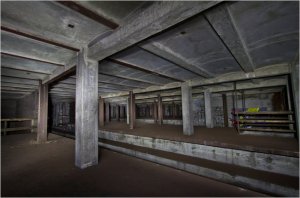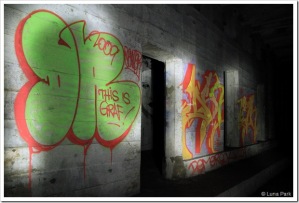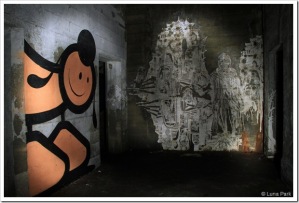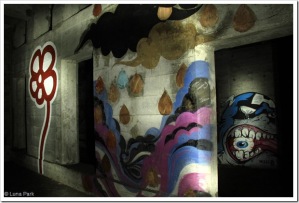I’ve been riding the NYC subway lines for nearly a decade now and must admit that sometimes, when I’m waiting for a train, I look into the darkness of the tunnel and have an urge to jump down and follow the tracks towards the blue light and wherever they lead me. I actually thought that this must be a pretty common feeling, given the propensity of graffiti on the walls between stations, but when I revealed this desire to some friends a few weeks ago, they gave me a long, hard look and quite clearly told me that this feeling, was in fact, not normal. I think I need new friends. Well, don’t get me wrong, I love them, but sometimes I do wish that they were more adventurous. Especially when stories like that of the Underbelly Project breaks and it was revealed that yes, there are no shortage of people who are willing to hop down into the tracks and wander into the darkness in order to explore the bowels of the NYC underground and leave behind hidden treats for subsequent adventurous spirits.
And what a treat it was for street art followers on Halloween, when the most comprehensive street art exhibition ever put together was unveiled by a freelance journalist by the name of Jasper Rees in the New York Times and in the National (it was also in the Sunday Times London, but you need a subscription to read that article). Since then, the word on the lips of every street art junkie has been “Underbelly.” Except this exhibition was actually a trick: the art wasn’t on the street, and almost no one will ever be able see it. Aptly named “the Underbelly Project” because it’s part of the hidden underground of NYC, the Underbelly Project has taken graffiti and street art back to its non-commercial roots, echoing the prolific period of NYC subway art of the 1970s and 1980s.
It wasn’t hard to figure out which abandoned station the Underbelly Project resides in (as I always say, with a bit of fingerwork, you can figure out anything with the help of the Internet). Since the exhibition was made public, urban spelunkers and subway lore fanatics have pinpointed the site to be that of the Broadway/South 4th Street Station in Williamsburg, Brooklyn. The history of the station is also a fascinating one (read more here): back in 1929 and 1939, when NYC was working to build up its subway system, Broadway/South 4th Station was to be a major transfer and connection point for the IND Second System. However, work began before the city even knew if funding for the remainder of the line would ever materialize. When World War II and the subsequent onset of the automobile age put a grinding halt to subway expansion, the project was halted and the 6 track station remained incomplete. Therefore, the South 4th Street Station is not an abandoned subway station (as it had never been functional) so much as it is a forsaken dream. However, it was at this shell station that two NYC street artists, PAC and Workhorse, realized a different dream: to showcase the work of a collection of street artists (both graffiti artists and fine artists) together in a non-commercialized exhibition space.
For the past 18 months in a series of about 75 visits, Workhorse and PAC have been escorting a total of 103 artists into the station to leave their creative marks on the walls. The rules were simple: only one trip per artist, which meant that they had about four solid hours to paint and had to walk into the site with all the equipment that they would need to finish their work. What I personally find most fascinating about this project is the representative cross-section of street artists. An estimate by the organizers pegs about 10% of the artists as female (which seems fairly representative in my opinion). Additionally, there are a good mix of both established and new artists, and quite a few international artists as well. Most interestingly, graffiti artists and fine artists have works exhibited side by side without the disconnect and friction that is sometimes seen above ground. Works by graffiti artists such as Demer and Asylum are next to works by fine artists such as Swoon and Ron English.
The roster of artists drawn to the project by the organizers is very impressive (although we must remember that these are friends, or referrals, so please don’t think of this as a “Best of Street Art” list, but rather those who were both in the know and able/available to work in NYC). From various sources, we can identify the works of Boxi, Ethos, London Police, SheOne, Remi Rough, Stormie Mills, Damon Ginandes, Lucy MacLauchlan, Swoon, Logan Hicks, Aiko, Faile, Ron English, Flying Fortress, Imminent Disaster, Dan Witz, Elbow Toe, Ripo, Peru Ana Ana Peru, Michael De Feo, WK Interact, Roa, Specter, Demer, Momo, Posterchild, Saber, Trusto Corp, Sinboy, Cash4, Rone Nick Walker, Revok, Ceaze, Know Hope, L’Atlas, M-City, Mark Jenkins, Meggs, Kid Acne, Lister, Jeff Soto, Smith/Sane, Gaia, Noh J Coley, Jim Darling, Thundercut, Daryll Peirce, Surge, Spazmat, Ema, Joe Lurato, Guilerme, JMR, Asylum, Gould, Indigo, Jeff Stark, Bigfoot, Kid Zoom, Strafe, to name a few (no particular order).
When Rees asked Workhorse why he and PAC have spent over a year curating an exhibition that nearly no one will ever see, Workhorse recited their statement of purpose: “In the beginning, street art was something you did because you didn’t fit in anywhere else. But for the last few years urban art was getting ridiculous. You could go out with some cute little character that you drew, or some quirky saying, and put it up everywhere for a few months, then do a gallery show and cash in on the sudden interest in urban art. It really was that easy for a while. Banksy pieces that were selling for $600 one year were suddenly selling for $100,000 a few years later. It was commercialism at its worst. The Underbelly was our way of feeling like we were an island again. We finally had a space in the world that collectors couldn’t contaminate. A space that couldn’t be bought.”
While I understand that this is a completely valid train of thought, I disagree with its sentiment. Look, I understand the desire to be naughty and self-indulgent and to go against the establishment. But street art isn’t just the newest hot commodity that’s been appropriated by every Sharpie-welding, sticker-slapping, stencil-making egomanic who wants to make a buck: it’s a great mode of expression and still attracts and inspires a certain type of recklessness. And yes, while a part of me despises the commercialism of the art game, we’ve got to realize that all this attention isn’t necessarily a bad thing: in fact, it’s legitimizing a form of art that should have been recognized as such decades ago. And I think that street art and graffiti deserves that kind of attention, and deserves to be recognized as an important urban cultural movement and genre in art history textbooks.
So in that sense, I completely agree with the lads at Graffoto (as in, don’t blame us for wanting to legitamize and expose your secret lifestyle). But I do respect and admire the fact that Underbelly has brought the risk back into art, and at least they’ve admitted that their interest was in creating art for the sheer sake of creating art, and that they just wanted to get a bunch of people together and do something a bit reckless that harkened back to the golden days of subway art. I’m glad they’ve gone to the press to let the world know about it, too. It might sound a little self-serving to the untrained ear, but the implications are much larger: art can exist everywhere, and artists are still having fun creating it. And with the shift of this type of art into the gallery-space, where trained curators will recontextualize it all and trained conservators will be concerned with its archival preservation, I think that this project was very important in that it it will serve to function as a last great guerrilla hurrah.
But of course, there are those of us who will still want to search out street art, or hidden architecture, or an urban adventure. To those of you who are tempted to search out this particular underground adventure, I would highly advise against it, as it’s both dangerous and illegal. Since news of the project broke, it has been revealed that much of the art has already been tagged up by a few disgruntled locals, and a few dozen people have been arrested in their attempt to climb down into the tracks in search of the artwork. The MTA, as is expected, don’t seem too pleased about the revelation of the Underbelly Project, and have taken a few measures of their own to prevent exploration, including stationing plainclothes cops on the platform. Though they have reiterated that such wanderings are deemed illegal as trespassing, they have simultaneously assured the public that they won’t be taking any measures to actively remove any artwork. (Though, as a conservator-in-training, I feel this point is moot and am forced to shake my head at PAC’s hopeful assessment that the pieces of the Underbelly Project will last three or four decades. In the end, it’s no more permanent than the art that many of these artists have created above ground.) Therefore, this unfinished station will retain these artworks as a poignant reminder that street art is ephemeral, and that no matter how hard we look, we’re bound to miss some of it.
Instead, keep your eyes and browser on the Underbelly Project website, which promises completion soon and will likely feature a comprehensive list of contributing artists, more photos, statements, and hopefully time-lapse video. Until then, the New York Times article has provided this video for your enjoyment. Also, please note that most photos in this post (except for the wide angle of the station, that was from the New York Times) were taken from Luna Park’s site. Definitely worth a visit, as she has managed to capture a significant portion of an unbelievable body of work.







